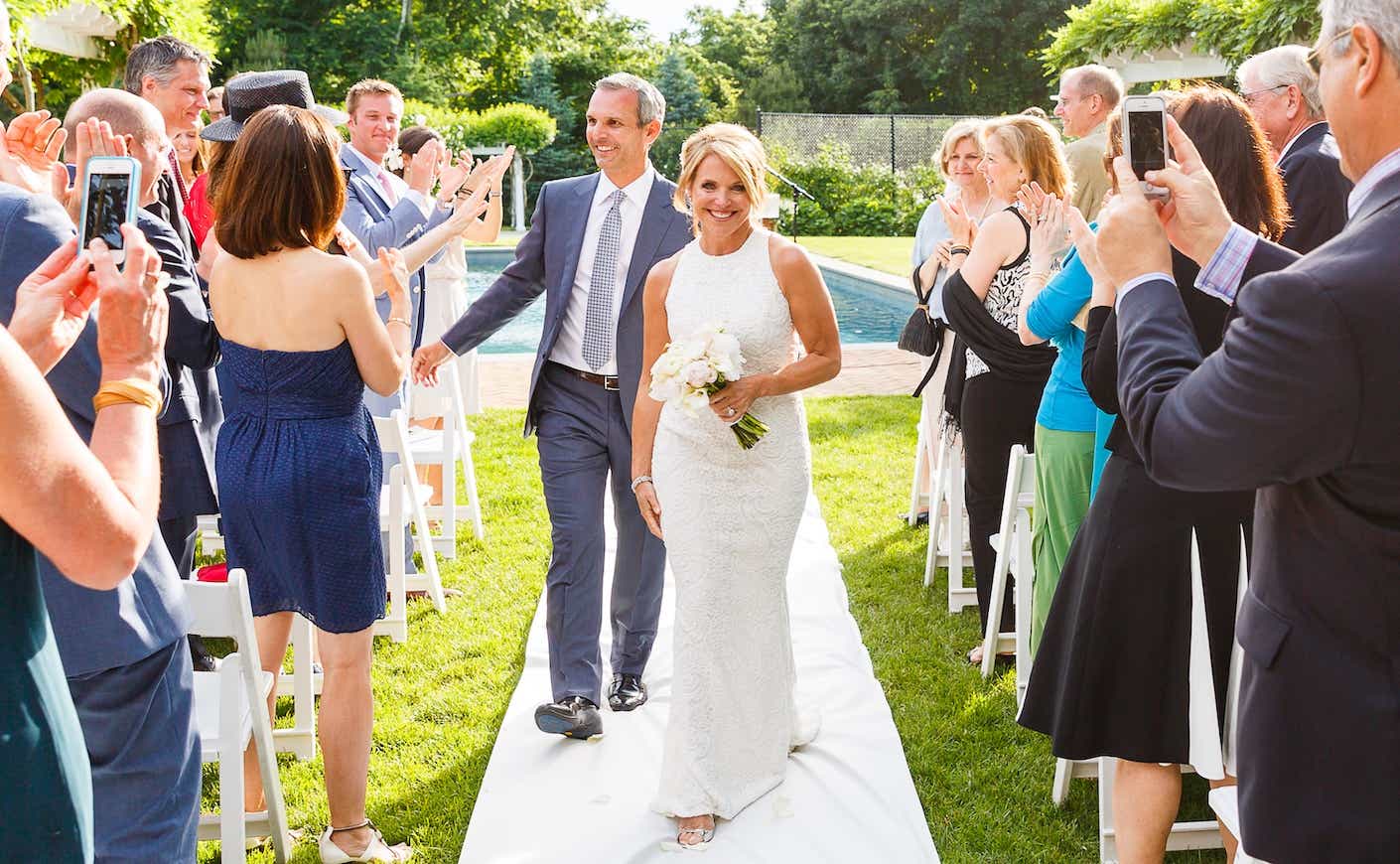We gathered expert advice to help you tie the knot at any life stage.
At KCM, we love weddings (you probably figured that out from the endless stories we shared from Katie’s daughter Ellie’s wedding!). We marvel at the careful consideration that goes into selecting dresses, flowers, and food, and we never tire of those DJ dance tracks. Even if we’re not invited to the wedding, we’re excited about it. Please, tell us all the details of your sister’s neighbor’s daughter’s soiree. What did they serve? What did she wear? What did they dance to?
Even more, we adore helping our readers plan for weddings, too, whether they’re the mother of the bride or groom picking out what to wear or the lucky couple making their registry.
But we’re also aware that most wedding tips are geared toward younger couples — those in their 20s and 30s who may be tying the knot for the first time. Sure, some advice is timeless, but plenty of us might be planning a second or third wedding or embarking upon our first marriage in mid-age.
Finding love at any stage of life is always something to celebrate. But we’re aware that a later-in-life wedding presents unique challenges. Of course, you have to deal with the more traditional issues: Assembling the perfect outfit, filling a registry (if you even want a registry), and considering the size of the wedding itself. But you might also experience some more unique stressors. How do you handle the delicate process of blending families? What if you’ve lost loved ones who might have fulfilled traditional roles in the ceremony? What if you simply feel a little uneasy being an older bride? Even at Katie and John’s fabulous wedding, Katie admitted that, “As a 57-year-old bride, I was a little self-conscious.” Luckily, when she saw all her friends and family celebrating, she experienced a boost of confidence.
If you need a boost of your own, we’ve consulted with some experts about how to tackle the logistical and emotional challenges of a later-in-life event. There’s a lot to consider, but if you proceed thoughtfully, there’s no reason why your wedding can’t be absolutely magical.
Blending families
We spoke with psychologist Jocelyn Charnas, Ph.D., about one of the trickiest aspects of a later-in-life marriage: Cobbling together a bigger, new family. When reimagining and reorienting your family, Dr. Charnas stresses that “patience is a virtue.” While you and your partner may be bursting with joy, Dr. Charnas emphasizes the importance of “taking time to gradually bring people together.” Though waiting may be frustrating, everyone will be ready at their own pace. You’re managing different personalities, people of different ages, and people who are undergoing different developmental milestones. Children, no matter their ages, need time to process the new marriage. (You might recall, Katie’s daughters weren’t exactly thrilled when she shared the news of her engagement to John – but look at them now! One big, happy family!)
Dr. Charnas advocates for “healthy, realistic expectations.” For instance, you may be very excited for your children to befriend the children of your future spouse. Maybe the kids are the same age or have a lot in common. But try your hardest not to exert pressure: It may take them years to bond. Or, they may never deeply bond at all. Again, let them go at their own pace and try to mindfully manage your expectations. If it doesn’t happen by the time the wedding rolls around, don’t rush it. It’s better that it happens naturally.
The prenup
Maybe you’re so ready for the great fun of a wedding that you don’t feel like having an awkward conversation about the prospect of divorce. But prenups are very important; especially later in life. We get it — it’s an uncomfortable topic. But Dr. Charnas stresses that real conflict arises when we avoid important conversations. “So much of my focus with engaged couples is to encourage and normalize talking about difficult things,” she says, and we would have to agree. Think of it this way: Dr. Charnas points out that “this time around, the focus should be on the relationship as much as the wedding.” Consider what’s best for your relationship, rather than the “happily ever after” performance. Like we said, the prenup talk won’t necessarily be easy — Dr. Charnas emphasizes that “wedding planning seems to shine a bright light on any issues in a relationship.” Just know that having a slightly off-putting interaction now can prevent a far more stressful conversation in the future. And keep in mind that if you’re not sure how to start the discussion, a couple’s therapist can help.
The bridal party
Weddings are blissful, sure, but they can also be bittersweet — especially if family members have passed. If you’re older, you’re even more likely to have experienced such a loss. If you don’t have a father to walk you down the aisle or a mother to help pick out a dress, try your hardest not to ignore those feelings of grief and loss. Dr. Charnas says that “we owe ourselves the time and space to feel those feelings.” Be sure to communicate those mixed emotions with your partner. When you feel ready to proceed, Dr. Charnas reminds us that “we all have to fill in the gaps in our lives with other people.” Carefully consider asking members of your “chosen family” to step in for those who cannot be present.
Wedding day-of coordinator Anadina Saladino mentioned that doing away with traditional roles can also be satisfying, especially if you went the traditional route the first time around: “You may also choose not to have any family walking down the aisle. Just have the focus be on you both.” If you’re concerned about retaining that “bridal party” look for photographs, Saladino has a tip: “You can ask your immediate family to dress in coordinating colors for photos and still achieve the feeling of a bridal party.”
If you have adult children, you can also include them in the ceremony. Saladino says that this is very common in later-in-life weddings: “Instead of having one side for women and one side for men at the altar, the adult children of both sides walk down the aisle and — regardless of gender — stand next to their parents.” Similarly, you can invert the roles usually reserved for young children. Saladino says, “we see flower women, flower men, and ring bearers that are women or men. Why not have your best woman be your daughter?”
The outfit
If you’re nervous about what you’re going to wear, that’s beyond understandable: Almost all of the attention is on you and you’re going to be photographed a ton. When it comes to your outfit, Saladino emphasizes that you should wear whatever clothing will make you feel incredible — and maybe that isn’t a dress. Saladino says that “it isn’t frowned upon to see a bride wearing color — sometimes multiple colors. Many brides now even opt for a formal evening dress they love, a pantsuit, a skirt suit, or even a jumpsuit. Anything goes!” If you’ve previously been married and felt pressured to wear a very conventional white dress, try to have fun breaking a few rules this time around.
The registry
If you and your partner want a registry, that’s great. But if you feel like you already have everything you need, there are fun and creative alternatives. Saladino says that it’s common for couples to collect funds for an experience instead: “Some websites allow you to register for a honeymoon fund, Broadway tickets, couple’s massages, and more.” If you and your partner are established enough that you don’t feel comfortable requesting money, ask your guests to donate to a charity instead.
The guests
As a later-in-life bride- or groom-to-be, it’s possible that you feel pressured to keep your ceremony small and somewhat demure. Once again, Saladino urges you to stay true to your desires: “It’s very appropriate to have a big wedding, even if you’ve done this before! Remember, this is a celebration of your new life together. It can be as lavish or intimate as you’d like it to be.” If you and your partner love big parties, why not throw a huge one? Conversely, if you feel more comfortable at smaller gatherings, then gather a few close friends and family members. But remember that even the smallest wedding can still be ridiculously fun. Saladino reminds us that “a smaller, intimate wedding shouldn’t be confused with a boring one. A lavish dinner party at an amazing restaurant can be just as incredible as a bigger celebration.”













